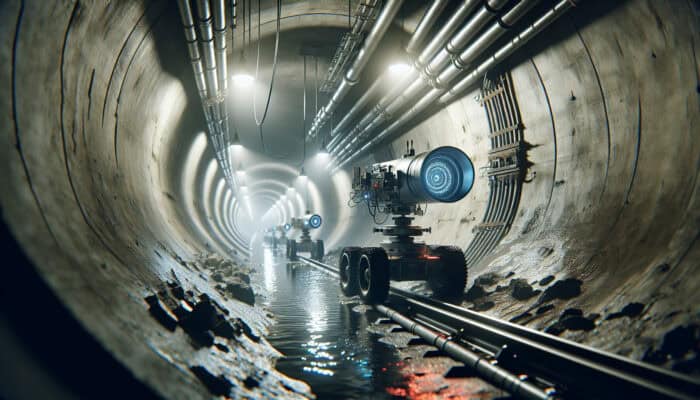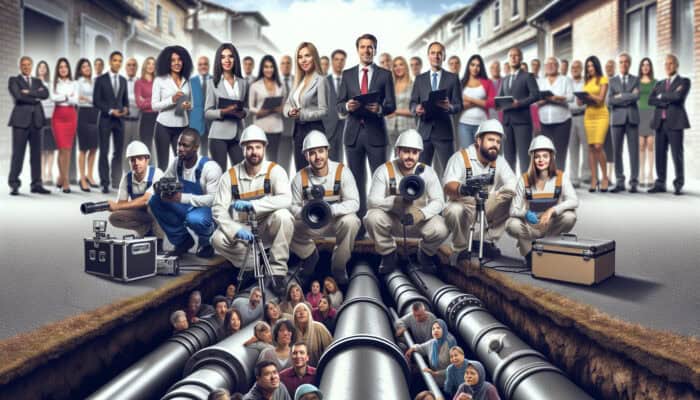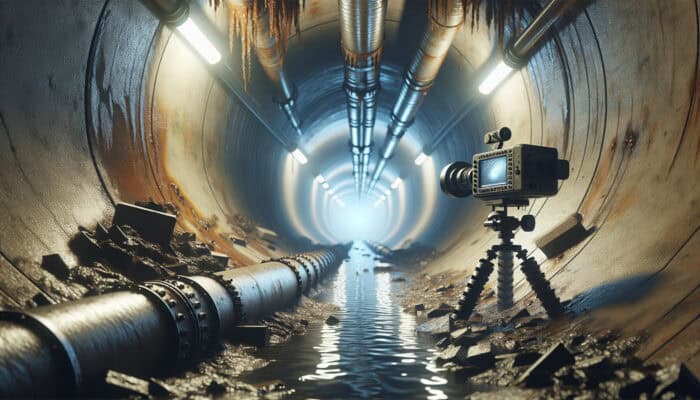Comprehensive Overview of Sewer Inspection Services Available in Mission
Understanding the Importance of Sewer Inspections for Infrastructure Preservation and Public Health

Sewer inspections are essential for safeguarding the health and wellbeing of communities, particularly in Canadian cities such as Mission. These inspections act as a proactive measure, allowing for the early identification of potential problems within the sewer systems, thus preventing them from escalating into expensive repairs or public health hazards. The significance of regular sewer inspections is evident through various crucial factors, including:
- Preventive Maintenance: Early detection of issues can significantly lower the risk of costly repairs in the future.
- Public Health Safety: Maintaining sanitary conditions diminishes the risk of disease outbreaks, thereby protecting community health.
- Environmental Protection: Timely inspections prevent leaks that may jeopardise local water supplies and ecosystems.
- Regulatory Compliance: Regular inspections assist property owners in adhering to local and national regulations governing sewer systems.
- Property Valuation: Consistent inspections can improve property value and enhance marketability.
- Operational Efficiency: Inspections guarantee that sewer systems function optimally, facilitating smooth operations.
Exploring the Innovative Techniques Utilised in Sewer Inspections Across Canada
In Canada, a diverse range of advanced technologies and methods is employed to ensure effective sewer inspections. This includes the use of CCTV (Closed-Circuit Television) inspections, sonar technologies, and innovative robotic devices. Each of these methods offers unique insights into the condition and integrity of the sewer infrastructure, which is crucial for timely interventions and necessary repairs that uphold public safety and system functionality.
Influence of Canadian Regulations on Sewer Inspection Practices
The sewer inspection process in Canada is governed by comprehensive regulations that are designed to uphold compliance and safety standards. These regulations encompass strict adherence to guidelines established by local municipalities and environmental agencies, dictating the timelines and methodologies for conducting inspections. This regulatory framework is vital for safeguarding public health and maintaining the integrity of essential infrastructure.
How to Select a Reliable Sewer Inspection Service in Mission?

When choosing a trustworthy sewer inspection service in Mission, it is crucial to evaluate several factors, including the company’s level of experience, the technology they employ, and client feedback. Engaging with local providers who possess a comprehensive understanding of the specific needs and challenges unique to the Mission area will ultimately yield the best results and highest quality of service, ensuring thorough evaluations and effective solutions.
In-Depth Insights on Sewer Inspection Services Available in Mission
Recent Innovations in Sewer Inspection Technology: What You Need to Know
The integration of cutting-edge technologies into sewer inspection services is significantly transforming the methodologies municipalities employ in this essential task. Advanced tools such as high-definition CCTV systems, drones, and AI-driven analytical software are currently being utilised to enhance the precision and quality of inspections. For example, municipalities in British Columbia have successfully incorporated drone technology to assess hard-to-reach sewer areas, resulting in greater efficiency and improved safety during inspections.
Recommendations from Experts on Sewer Inspection Scheduling

Industry experts generally recommend that property owners schedule sewer inspections at least every two years. For older systems or those with a documented history of issues, more frequent assessments are advisable. To maintain optimal system health, it is prudent to conduct inspections prior to the winter months and following heavy rainfall events, as these periods can place additional stress on sewer systems. Establishing a regular maintenance schedule can significantly enhance the longevity of sewer infrastructure.
Case Studies Illustrating Successful Sewer Inspections in Canada
Numerous compelling case studies across Canadian municipalities exemplify the significant advantages gained from routine sewer inspections. For instance, a recent initiative in Vancouver identified major blockages that, if left unaddressed, could have resulted in severe flooding incidents. By acting swiftly, the city not only mitigated potential repair costs but also enhanced the overall quality of life for its residents, thereby showcasing the value of proactive sewer management practices.
Environmental Benefits Linked to Regular Sewer Inspections
Regular sewer inspections play a pivotal role in promoting environmental protection. By identifying leaks and potential contamination points at an early stage, municipalities can prevent harmful substances from entering local waterways. In Mission, successful initiatives have been implemented to reduce sewer overflow incidents, resulting in cleaner streams and healthier ecosystems that positively affect local wildlife while enhancing overall community health and wellbeing.
Effective Preparation Strategies for Property Owners Before a Sewer Inspection
To ensure a smooth sewer inspection process, property owners should proactively take several steps. A well-prepared property can significantly enhance the efficiency of inspections. Key preparation tips include:
- Clear Access: Ensure that all access points to the sewer system are free from obstructions, facilitating easy entry for inspection crews.
- Document Previous Issues: Provide inspectors with records of any past sewer-related problems to assist in their assessment.
- Notify Residents: Inform tenants or residents about the upcoming inspection to ensure cooperation during the process.
- Check for Blockages: Remove any visible blockages near sewer access points to facilitate an unobstructed inspection.
Common pitfalls to avoid include failing to inform the inspection team about any prior issues or neglecting to adequately prepare access points for the inspection team, which can lead to delays and complications that hinder the inspection process.
Step-by-Step Process of Sewer Inspection Services in Mission
Sequential Steps Involved in Conducting a Comprehensive Sewer Inspection
The procedure for a sewer inspection typically begins with an initial assessment conducted by trained technicians, who evaluate the overall condition of the sewer system. This is followed by deploying specialised inspection equipment, such as CCTV cameras, to gather detailed insights regarding the condition of the system. After a thorough analysis, a comprehensive final report is compiled, detailing findings and providing recommendations for any necessary repairs or maintenance actions that may be needed to ensure the system remains functional and safe.
Essential Equipment and Tools Employed During Sewer Inspections
In Mission, a variety of specialised equipment and tools are utilised during sewer inspections. This includes:
- CCTV Cameras: These cameras are pivotal for visual inspections of the interiors of pipelines, providing real-time footage for accurate assessments and evaluations.
- Sonar Equipment: Utilised to detect blockages and accurately measure the dimensions of pipes, ensuring comprehensive assessments.
- Robotic Crawlers: Designed to navigate hard-to-reach areas within sewer systems, enhancing inspection capabilities and efficiency.
- Hydraulic Equipment: Employed to clear blockages during inspections, ensuring unobstructed flow and accurate evaluations of the sewer system.
Each tool serves a specific purpose, contributing to the overall effectiveness and thoroughness of the inspection process, ensuring that all aspects of the sewer system are adequately evaluated and maintained.
The Crucial Role of Technicians in Conducting Sewer Inspections
Technicians play an indispensable role in executing sewer inspections, requiring a unique blend of skills and expertise to ensure effective evaluations. Their primary responsibilities include operating inspection equipment, analysing the data collected, and preparing detailed reports for property owners and municipalities. Essential skills for technicians encompass:
- Technical Proficiency: The capability to operate complex inspection equipment effectively and safely, ensuring accurate results.
- Analytical Skills: The ability to interpret collected data accurately and diagnose potential issues efficiently, facilitating prompt action.
- Problem-Solving: Skills necessary to recommend effective solutions based on inspection findings, ensuring that problems are addressed in a timely manner.
- Communication: The capability to convey technical information clearly and understandably to non-expert audiences, facilitating better understanding and cooperation.
Each of these competencies is vital in ensuring that sewer systems are maintained in optimal condition, functioning efficiently for the benefit of the entire community, ultimately safeguarding public health and infrastructure.
Benefits of Sewer Inspection Services for Residents of Mission
How Early Detection Prevents Costly Repairs for Property Owners
Regular sewer inspections serve as a critical mechanism for preventing costly repairs for property owners in Mission. By identifying issues such as cracks or blockages at an early stage, property owners can significantly mitigate the risk of extensive damage that could lead to substantial repair costs. Investing in routine inspections is a proactive strategy that ultimately pays dividends over time, protecting both finances and property integrity, while ensuring the longevity of the sewer system.
Enhancing Public Health and Safety Through Effective Sewer Inspections
The impact of sewer inspections extends beyond mere infrastructure; these inspections are vital for ensuring public health and safety. Well-maintained sewer systems play a crucial role in preventing sewage leaks and overflows that can pose serious health hazards, including waterborne diseases. By prioritising regular inspections, communities like Mission can maintain sanitary conditions, significantly improving the quality of life for their residents and ensuring a safer environment.
Contributions of Effective Sewer Management to Environmental Protection
Effective sewer management, supported by consistent inspections, plays a pivotal role in advancing environmental protection initiatives across Canada. By identifying leaks and potential contamination sources, communities can proactively address issues that threaten local ecosystems and wildlife. This commitment to environmental stewardship is particularly evident in Mission, where initiatives focused on improved sewer management have resulted in cleaner waterways and healthier habitats for local flora and fauna, promoting biodiversity and ecological balance.
Increasing Property Value and Marketability Through Regular Sewer Inspections
For homeowners and real estate investors, conducting regular sewer inspections can significantly boost property values and enhance marketability. Buyers today are increasingly aware of the importance of a well-maintained sewer system, viewing inspections as a vital component of property assessments. Ensuring that sewer systems are in excellent condition can make properties more attractive to potential buyers, thereby increasing overall market value and investment potential.
Effective Strategies for Optimising Sewer Inspection Services in Mission
Best Practices for Conducting Thorough Sewer Inspections
Implementing best practices in sewer inspections is essential for achieving high-quality results that meet community needs. Key strategies include thorough pre-inspection preparations, utilising the latest technologies, and maintaining clear and open communication with property owners throughout the entire inspection process. By adhering to these steps, inspection teams can maximise efficiency and accuracy in their assessments, ensuring comprehensive evaluations that address all potential issues while fostering trust with the community.
The Importance of Training and Certification for Sewer Inspection Professionals
Continuous training and certification for professionals in the sewer inspection industry are vital for maintaining high standards of service. These programmes equip technicians with the latest knowledge and skills necessary to navigate evolving technologies and comply with regulatory requirements. Investing in professional development ensures that inspection services remain authoritative, reliable, and capable of meeting the diverse needs of the community, ultimately enhancing service delivery and public trust.
Common Challenges Encountered During Sewer Inspections and Their Solutions
Common challenges faced by technicians during sewer inspections in Canada include restricted access, aging infrastructure, and various environmental factors that may complicate the inspection process. Effectively addressing these challenges often requires innovative solutions, such as utilising robotic technology for hard-to-reach areas or adjusting inspection schedules based on prevailing weather conditions. By proactively tackling these obstacles, municipalities can ensure more effective inspections and achieve better outcomes for their communities, thereby enhancing overall efficiency.
Emerging Trends in Sewer Inspection Services in Mission
How Smart Technology is Transforming the Future of Sewer Inspections
Emerging smart technologies are poised to revolutionise sewer inspections throughout Canada. Innovations such as IoT (Internet of Things) sensors and cloud-based analytics are transforming how municipalities monitor and manage sewer systems. These advanced technologies enable real-time data collection and analysis, allowing for quick responses to potential issues, significantly improving overall system management and efficiency while ensuring better resource allocation and problem-solving.
Integrating Sustainable Practices into Sewer Inspection Services
Canadian sewer inspection services are increasingly adopting sustainable practices aimed at minimising their environmental impact. This includes utilising eco-friendly materials and methods in repair and maintenance processes. By prioritising sustainability, municipalities not only contribute to broader environmental objectives but also ensure effective sewer management that aligns with community values and fosters public trust, ultimately benefiting residents and the environment.
The Role of Artificial Intelligence in Future Sewer Inspections
The future applications of AI in sewer inspections are vast and promising. AI technology has the potential to enhance predictive analytics capabilities, enabling municipalities to anticipate potential issues based on historical data and usage patterns. As technological advancements continue to unfold, AI is set to become an integral component of optimising sewer management systems, improving efficiency, and ensuring compliance with environmental standards.
Frequently Asked Questions Regarding Sewer Inspection Services
What Does a Sewer Inspection Service Entail?
A sewer inspection service involves evaluating the condition of sewer lines using specialised equipment to identify potential problems such as blockages, cracks, or leaks, thereby ensuring the integrity of the infrastructure and safeguarding public health.
How Frequently Should Sewer Inspections Be Conducted?
It is generally advisable to perform sewer inspections every two years; however, more frequent assessments are recommended for older systems or those with documented issues to ensure ongoing integrity and functionality.
What Technologies Are Commonly Utilised in Sewer Inspections?
Common technologies employed during sewer inspections include CCTV cameras, sonar equipment, and robotic crawlers, which provide detailed insights into the current condition of sewer systems and enhance assessment accuracy, leading to better management decisions.
Why Are Sewer Inspections Critical for Safeguarding Public Health?
Regular sewer inspections are essential for preventing leaks and overflows, which in turn maintain sanitary conditions and reduce the risk of waterborne diseases, ultimately protecting public health and safety within communities.
What Steps Should Property Owners Take to Prepare for a Sewer Inspection?
Property owners should ensure that access points are clear, document any previous issues, notify residents about the inspection, and check for visible blockages prior to the assessment to facilitate a smooth and efficient process.
Can Regular Sewer Inspections Enhance Property Value?
Absolutely, consistent sewer inspections can significantly boost property value by ensuring that the sewer system is functional and well-maintained, making the property more appealing to potential buyers in the competitive market.
What Challenges Do Technicians Encounter During Sewer Inspections?
Technicians may face challenges such as limited access, aging infrastructure, and adverse environmental conditions, all of which can complicate the inspection process and require adaptive strategies for effective resolution.
How Does AI Enhance the Sewer Inspection Process?
AI improves sewer inspections through predictive analytics and data analysis, enabling municipalities to proactively identify potential issues based on historical usage data, thereby improving overall management strategies and system efficiency.
What Role Do Regulations Play in Sewer Inspection Services?
Regulations established by local municipalities and environmental agencies dictate the standards and procedures for sewer inspections, ensuring compliance, safety, and the protection of public health and the environment.
How Can Municipalities Encourage Sustainable Practices in Sewer Inspections?
Municipalities can adopt eco-friendly materials and methods, implement cost-effective technologies, and prioritise environmental stewardship in their overall sewer management strategies to promote sustainability and enhance community wellbeing.
Connect with us on Facebook for More Insights!
The Article: Sewer Inspection Services in Mission: Ensuring Canadian Infrastructure Health First Published On: https://pacificbluemechanical.ca/
The Article Sewer Inspection Services: Safeguarding Mission’s Infrastructure Was Found On https://limitsofstrategy.com

